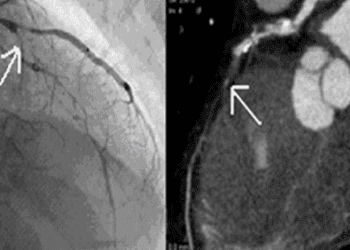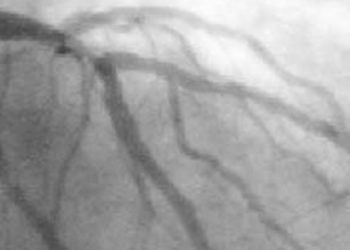Cardiac risk factors associated with noncalcified plaque burden in asymptomatic patients
1. In asymptomatic patients with low-to-moderate risk for coronary artery disease, computed tomography coronary angiography revealed increased total coronary plaque index in men than in women.
2. Total non-calcified, soft coronary plaque burden in asymptomatic patients was associated with risk factors for cardiovascular disease including low-density lipoprotein cholesterol levels, diabetes, and hypertension.
Evidence Rating Level: 2 (Good)
Study Rundown: Coronary artery disease (CAD) is the leading cause of death worldwide, and is primarily assessed and managed through indirect measures, such as cardiac risk factor mitigation. Direct imaging of plaque burden is often reserved for severe disease due to the invasive nature of coronary catheterization and intravascular ultrasound, but computed tomography (CT) coronary artery calcium (CAC) scores are becoming increasingly common among mild to moderate risk patients. However, CAC fails to capture noncalcified plaque burden, which is less stable and more likely to rupture. Noncalcified plaque is both the plaque component which may be reversible with intensive therapy and is directly associated with the risk of fatal cardiovascular events and may be imaged in an accurate, noninvasive fashion with CT coronary angiography (CTCA), potentially providing a more direct measure for patient risk stratification. This study employed CTCA to assess the relationship between calcified and non-calcified plaque quantity in the coronary arteries and their relationship to cardiovascular risk factors in low- to moderate-risk asymptomatic individuals. Using CTCA, all coronary plaque throughout the entire coronary vascular tree was measured in asymptomatic patients who were eligible for statin therapy. Controlling for all risk factors, the results showed that total coronary plaque index was greater in men than in women. Non-calcified plaque index was also found to be positively correlated with systolic blood pressure, LDL cholesterol levels, diabetes status, and established cardiovascular risk scores such as the Framingham risk score and the 2013 American Heart Association risk score. The findings of this study support the use of CTCA in accurate, direct risk stratification of asymptomatic individuals with cardiac risk factors. The study was primarily limited in that CTCA was not compared to a reference standard such as intravascular ultrasound and that it was performed at a single academic medical center, potentially limiting generalizability. Future studies should aim to determine the longitudinal effect of high-intensity statins or other therapies on total plaque burden using CTCA.
Click to read the study in Radiology
Relevant Reading: Beyond coronary stenosis: coronary computed tomographic angiography for the assessment of atherosclerotic plaque burden
In-Depth [prospective cohort]: A total of 202 asymptomatic patients (36% women with mean age 65.5 years ± 6.9) who were eligible for statin therapy were recruited for the study. Coronary CT angiography was performed using a 320-detector row CT scanner and an intravenous contrast agent. Coronary wall thickness and plaque deposition was evaluated, and multivariable regression analysis was performed to determine the relationship between risk factors and total plaque index, defined as plaque volume divided by vessel length. The median coronary artery calcium score was 73 (interquartile range, 1–434) and total coronary plaque index was significantly higher in men at 42.06 mm2 ± 9.22 versus women at 34.33 mm2 ± 8.35 (p < .001). Non-calcified plaque index was positively correlated with systolic blood pressure (β = 0.80 mm2/10 mmHg; p = .03), diabetes (β = 4.47 mm2; p = .03), and LDL level (β = 0.04 mm2/mg/dL; p = .02).
Image: PD
©2015 2 Minute Medicine, Inc. All rights reserved. No works may be reproduced without expressed written consent from 2 Minute Medicine, Inc. Inquire about licensing here. No article should be construed as medical advice and is not intended as such by the authors or by 2 Minute Medicine, Inc.









